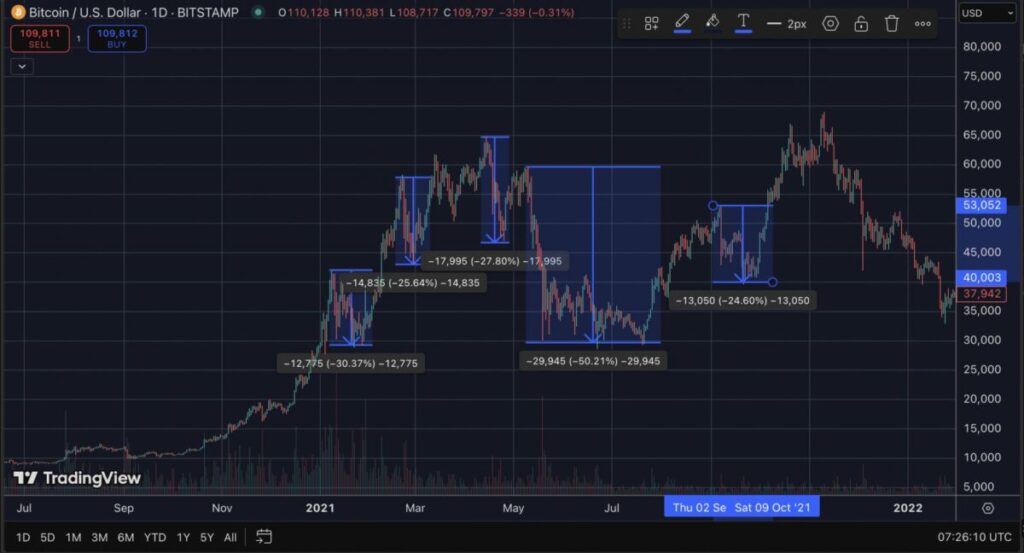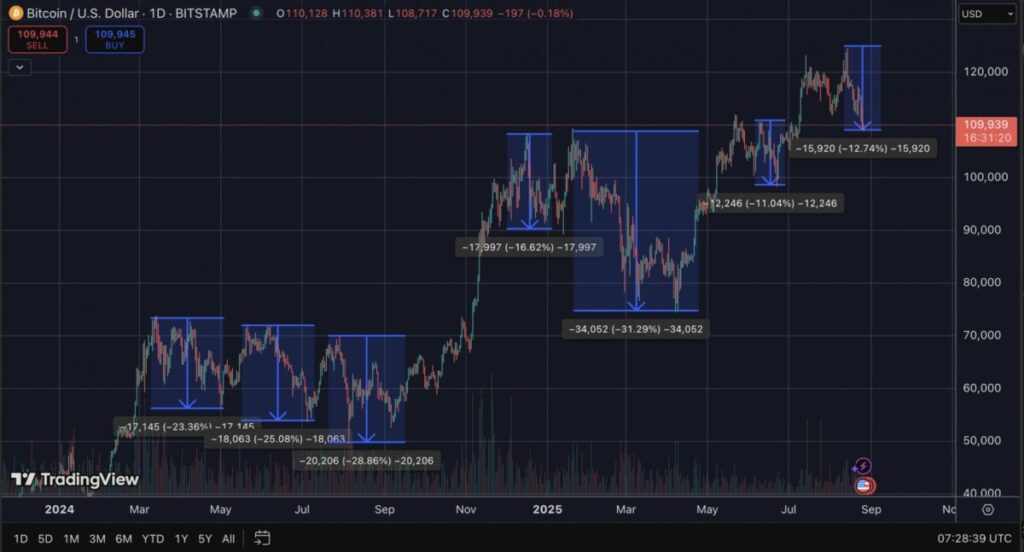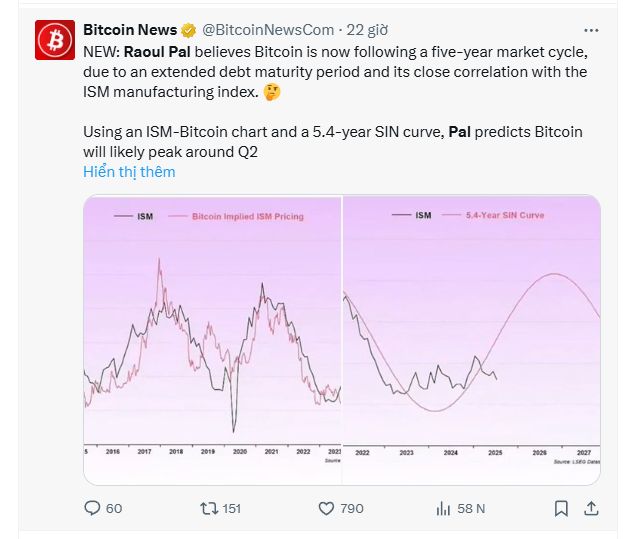
The crypto market has almost completed Q3/2025, with BTC holding firmly above $100k for an extended period. This year marks a crucial milestone in the crypto cycle. Historically, crypto follows a 4-year cycle: a long accumulation phase, followed by a year of explosive growth known as the “bull run”, and then a sharp correction that ushers in a prolonged bear market.
We are now in the middle of the 2025 bull run. But as the days of this year tick away, a key question emerges: will this cycle once again end after 4 years, like in the past, or will 2025 break the mold?
1.What is a Crypto Bull Run?
A bull run refers to a period of strong upward price movement across the crypto market, a critical phase within the broader cycle: decline → accumulation → rally → repeat.
This uptrend typically starts with Bitcoin, then flows into large-cap altcoins, and eventually spreads across the entire market. Historically, Bitcoin’s 4-year cycle has been remarkably consistent, with bull runs taking place in year four: 2013, 2017, 2021, and now 2025.
To visualize:
- The 2021 bull run felt like a street party — loud, colorful, chaotic, and euphoric.
- The 2025 bull run, in contrast, resembles a formal gala dinner — organized, institutional, with Wall Street giants and global financial players now seated at the table. Their presence makes this cycle feel potentially longer and more sustainable.
2.Key Differences Between 2021 and 2025 Bull Runs
2.1 The 2021 Cycle – NFTs, Play-to-Earn, Metaverse
Back in 2021, crypto was the playground of digital creators.
- NFT : Non-Fungible Tokens exploded, from art to pop culture, creating the illusion that “anyone can get rich” by owning the right JPEG.
- Play-to-Earn (GameFi): Axie Infinity and early Metaverse projects offered a new narrative: “play games, earn real money.” Game tokens became income streams for players.
- Metaverse Buzz: Platforms like Decentraland and The Sandbox captured attention, allowing people to own land, trade, socialize, and build in virtual worlds.
- DeFi Expansion: Following its 2020 breakout, liquidity continued to flood lending protocols, DEXs, and stablecoins, laying the foundation for massive on-chain liquidity.
- Layer 1 Explosion: Ethereum’s high gas fees fueled the rise of Solana, Avalanche, Terra, and BSC — the era of “ETH killers.”
- Memecoin Culture: DOGE, SHIBA, FLOKI — not just tokens, but cultural and social movements that brought entertainment and retail adoption.
- Institutional Entry: MicroStrategy, Tesla, and El Salvador bought Bitcoin, pushing it into mainstream finance.
- Social Tokens & DAOs: Communities began tokenizing themselves, experimenting with DAO governance and collective ownership.

2021 Cycle: Spike then Deep Correction => 2021 was the peak of digital culture and creative hype, while also laying the groundwork for infrastructure growth (L1/L2) and institutional awareness — transforming crypto from a niche playground into a global phenomenon.
2.2 The 2025 Cycle – RWAs, AI, Institutional DeFi, Memecoin
By 2025, the focus has shifted dramatically toward real-world utility and financial integration.
- RWA Tokenization: Real-world assets (real estate, bonds, art, etc.) are being tokenized into highly liquid, transparent, and accessible forms. Projections suggest the RWA market could reach $16 trillion by 2030.
- AI x Crypto (DeFAI): From autonomous AI trading bots to AI-powered data protocols, AI is supercharging crypto projects with intelligence and efficiency.
- Crypto ETFs & Stablecoins: Bitcoin and Ethereum ETFs are now live, enabling pension funds, insurers, and corporations to invest in crypto as easily as stocks. At the same time, stablecoins (USDT, USDC) have become the backbone of global payments — effectively “USD on blockchain,” faster and cheaper than banks.
- DePIN (Decentralized Physical Infrastructure Networks): Merging blockchain with real-world infrastructure:
- Community-powered decentralized internet/5G networks.
- Tokenized renewable energy (solar, wind) markets.
- Real-world data (maps, sensors, AI datasets) on-chain, rewarding contributors.
- Memecoin & InfoFi:
- In 2021, NFTs defined digital culture. In 2025, memecoins define market culture. Platforms like Pump.fun, LetsBONK, and Boop.fun gamify token launches, making it possible for anyone to spin up a meme coin with just a few dollars.
- InfoFi (Kaito, Cookie, StayLoud…) elevates memes further: attention → liquidity. Here, memes aren’t just funny images — they’re fueled by social trends, information flows, and community narratives.
- Memecoins have become the fastest liquidity flywheel, where retail can participate most easily. Some are no longer “just for fun” but are tied to launchpads, communities, and even politics (e.g., Trump or Biden meme tokens).

Cycle 2025: Mild, prolonged correction, reaction to macro news. => 2025 marks a transition from culture-driven speculation (2021) to integration with global finance, data, and AI — where real utility and infrastructure are the dominant narrative.
3.Regulation & Policy: From Uncertainty to Clarity
Back in 2021, crypto regulation was murky. Under SEC Chair Gary Gensler, everything except Bitcoin was considered a security. Endless lawsuits stifled growth, creating fear among builders and investors. Only Bitcoin futures ETFs existed; there were no clear stablecoin rules or institutional frameworks. Institutions stayed cautious, retail remained shaky.
Fast-forward to 2025, the landscape has flipped:
- Trump Presidency: The election of pro-crypto President Donald Trump, along with Gensler’s departure, has dramatically improved market sentiment. Pro-crypto laws and policies are being rolled out, with even Trump’s family actively engaging in the ecosystem.
- GENIUS Act (July 18, 2025): The first federal law defining “payment stablecoins.” Stablecoins must be backed 1:1 by USD or safe assets, with public reserves and federal/state oversight. Within one month of the law’s signing, stablecoin market cap jumped from $260B to $278B (+7%).
- Strategic Bitcoin Reserve (March 6, 2025): Trump established a national Bitcoin reserve — confiscated BTC is no longer sold but held as part of the U.S. strategic reserves. States like New Hampshire and Texas are also creating their own Bitcoin reserves.
- Legitimization of BTC & Stablecoins: These steps move crypto from a speculative playground into the core of traditional finance. Bitcoin and stablecoins are increasingly viewed as reserves (like gold) and legal payment instruments.
=> Crypto has gone from wild west → professionalized market. Bitcoin remains decentralized, censorship-resistant, and valuable — now with added legitimacy as a reserve asset.
4.Does the 4-Year Cycle Still Hold?
For years, crypto has closely followed the 4-year cycle tied to Bitcoin halving. Each halving brought a bull run, followed by a brutal winter. This made many investors assume 2025 would again be the final year of the cycle before collapse.
But voices like Raoul Pal (ex-Goldman Sachs hedge fund manager, Real Vision co-founder) suggest this time might be different: Bitcoin could shift to a 5-year cycle.
If true, the current bull run could extend for months or even years longer than expected.
Two scenarios emerge:
- If 4-year cycle repeats: The market may only have a short window left for explosive gains before correction. Best to secure profits, reduce risk, and rebalance portfolios.
- If extended to 5 years (or longer): This bull run could last much longer, bringing new opportunities. But overconfidence could cause investors to miss the chance to take profits.

=> Either way, the key lesson: you can’t control the market, but you can control risk management. If you feel constant stress, you’re likely overexposed. Take some profits, ease the pressure, and rebalance.
5.Conclusion
All assets move in cycles — 4 years, 5 years, even 10 years. Crypto is no exception. It will gradually synchronize with the broader rhythm of global financial markets: nothing rises forever, and nothing falls forever.
Cycles are loops. Those who learn to ride them will accumulate lasting wealth for themselves and their families.
Disclaimer: This content does not constitute investment, tax, legal, financial, or accounting advice. MEXC provides this information for educational purposes only. Always DYOR, understand the risks, and invest responsibly.
Join MEXC and Get up to $10,000 Bonus!
Sign Up


